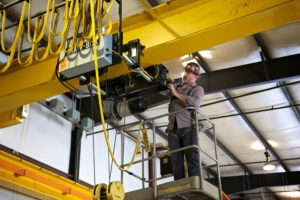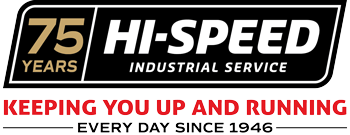 It’s no secret that any operating overhead crane’s reliability, safety, and longevity are contingent upon and directly related to regular inspections and proper maintenance. And while reliability and longevity might sound like abstract terms, both have real-world implications for the business’ productivity, worker well-being, and profitability.
It’s no secret that any operating overhead crane’s reliability, safety, and longevity are contingent upon and directly related to regular inspections and proper maintenance. And while reliability and longevity might sound like abstract terms, both have real-world implications for the business’ productivity, worker well-being, and profitability.
OSHA guidelines require that every overhead crane be inspected annually, with the dated reports stored for future reference. However, more frequent inspections, such as quarterly, monthly, or daily, can help reduce excessive downtime for maintenance and repairs. Here are a few factors to consider when establishing a proactive crane inspection and maintenance routine.
Age: Older cranes and those with extensive usage require inspections more often than newer cranes.
Function: Cranes that perform more complex activities should be inspected more frequently due to the additional components and assemblies utilized.
Frequency of Usage: Cranes used regularly or extensively should be inspected more frequently than cranes rarely used. OSHA has created a separate set of inspection rules for cranes that are typically idle.
Capacity: Due to the inherent dangers of massive loads, higher-capacity cranes should be inspected more frequently than those with lower capabilities.
Downtime: The longer a crane is down for repairs, the more often it needs to be inspected.
Crane Inspection Checklist
Many crane components are included in the inspection process per OSHA 29 CFR 1910.179, but here is a general checklist that most companies can use.
Horns: Cab-controlled cranes and those that use radio controls must have horns (audible alert) to warn nearby workers that a load is moving.
Warning Lights: Cab-controlled cranes must also have flashing, colored, or strobe lights to visually alert nearby workers that the crane is in operation.
Crane Lights: Typically mounted to the underside or structure of a crane to increase the visibility of the floor, nearby workers, and potential crane hazards.
Limit Switches: Prevent damage to the crane and runway by slowing the trolley travel before hitting the end-stops. The pre-programmed limits can also alert the operator that the crane is approaching an obstacle or stopping point.
Walkways: Typically added to a crane to provide access to the operator and maintenance personnel, workers should inspect them regularly for potential trip hazards or excessive wear. Walkways require an additional employee to monitor their use from the ground and do not eliminate the need for fall protection.
Overload Sensors: These devices report the actual load weight lifted to the operator. Maintenance and service technicians can use the captured data for future troubleshooting and repairs.
Radio Control: Improve operator safety since the crane is operated remotely instead of using a pendant (tethered) control unit. Today’s units also feature two-way communication, allowing the device to send and receive operational commands and data.
Collision Avoidance Systems: Track and monitor each crane on the runway to avoid collisions with the end-stops, obstructions, and other crane(s).
Brake Slip Monitoring: Besides documenting brake slippage for future troubleshooting or repairs, these systems alert operators and service teams when an adjustment is needed.
Variable Speed Drives: Provide smoother starts and stops to eliminate load swings from hard starts and sudden stops while reducing mechanical wear and drive train impact loads.
Runtime Monitoring: These devices assemble the data collected by different sensors located on the crane equipment, which can include:
- Load magnitude
- Contactor switch functions
- Travel distance/duration
- Total operating hours
- Load histograms
Technicians can use collected data to determine scheduling for maintenance activities and when the equipment has reached its useful life.
Maintenance teams should immediately address any preventative maintenance or repair issues identified during an inspection to help maximize worker safety and the crane’s life and productivity.
Crane Inspection Record Keeping
Proper record-keeping is another essential component of the crane inspection process. A legible, written, or digital inspection record can be used for streamlining future maintenance procedures and the event of an equipment or safety audit. Crane inspection reports should include the following:
- Dates of all maintenance work or crane inspections.
- Names and certifications of the person(s) conducting the inspection or service.
- Type of work performed (electrical, mechanical, computer system) and the parts serviced, refurbished, or replaced.
- Official work orders upon completion of the inspection.
- List any irregularities found during the inspection process.
Crane inspections and regular maintenance improve worker safety and protect valuable company assets while reducing equipment downtime and emergency repair costs.
If you want to learn more about crane inspections or establish a new or improved preventative maintenance plan, you can email the Hi-Speed Crane Experts or call us today at 800-713-0103.

